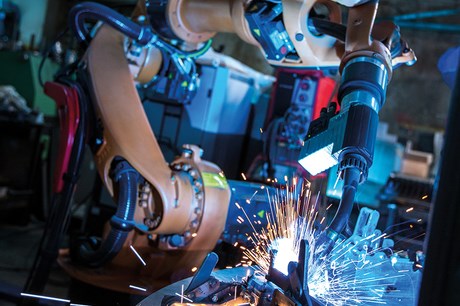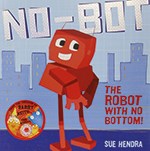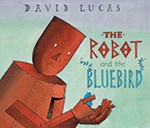EYFS Activities: Let's explore… robots
Marianne Sargent
Monday, August 22, 2016
Robots play a part in many aspects of our lives and are a fun learning topic, explains Marianne Sargent

Our lives are inextricably linked to and in many ways controlled by technology. Robots play a large part in our everyday existence, working behind the scenes to provide a whole range of services and products that we take for granted on a daily basis. Plan a topic on robots to introduce children to the benefits of technology, robotics and modern engineering, while having a little bit of fun along the way.
ROBOTS IN LIFE
Unfortunately, there are no up-to-date children's information books about the role of robots in our everyday lives. Possibly the most recent is the Discover Science title Robots by Belinda Weber and Clive Gifford (Kingfisher, 2011). But you can find photos online to create a slide show of examples of how robots make our lives easier. For example:
- manufacturing – car assembly, etc
- healthcare – in operating theatres
- stock control – storing and selecting stock in warehouses
- farming – harvesting crops
- housekeeping – such as hoovering.
Share the examples, drawing links with the children's everyday lives to demonstrate how robots make an impact. For example, without robots it would take longer to grow crops, so there would be less food available to buy. When the children's parents buy something online, it is usually picked and packed by robots. Robots also make it possible to carry out operations on patients more accurately and safely, helping more people to survive serious illness.
Ask the children: if they could invent any type of robot, what would it do and why?
Challenge them to design their robot in detail; they could either tell you about it, draw a picture or build a model of their design.
Learning opportunities
CL Begins to understand ‘how’ and ‘why’ questions; uses talk to organise sequence and clarify their thinking, ideas, feelings and events.
UW Talks about why things happen and how things work; recognises that a range of technology is used in places such as homes and schools.
ROBOTS IN SPACE
Find out about the robots that assist with space exploration. Humans have as yet been unable to visit any of the other planets in our solar system. The length of the journey means it would be difficult to survive because of our need for food, water and physical exercise. Robots, however, do not need any of these things.
There have been robots exploring the atmosphere and geology of Mars for more than 13 years. These robots travel on the surface, taking photographs and analysing soil samples before sending the data back to scientists here on Earth. This has allowed us to learn a tremendous amount about the red planet.
Then there is NASA's Juno space probe, which recently entered Jupiter's orbit after a five-year journey to reach it. The probe will collect information about Jupiter's atmosphere, composition and magnetic and gravity fields so scientists can work out how our solar system came into existence.
Go to the NASA website to find out about robotics (www.nasa.gov/audience/forstudents/k-4/stories/nasa-knows/what_is_robotics_k4.html) and access some interactive Mars exploration activities, plus images of the different robotic rovers currently on the planet (http://mars.jpl.nasa.gov/participate/funzone).
You can find a short video about the Juno mission on the CBBC Newsround website (www.bbc.co.uk/newsround/36684080). Although this is for older children, there are some great images of the Juno probe.
Use large cardboard boxes to make a role-play space probe that the children can pretend to send to explore outer space.
Set up a control centre with computers, graph paper, clipboards, flip charts and telephones.
Learning opportunities
UW Talks about why things happen and how things work; recognises how a range of technology is used.
EAD Plays alongside other children who are engaged in the same theme.
ROBOT DANCING
Dig out some electro-pop from your 1980s music collection (I know you’ve got some somewhere) and get the children dancing like robots.
Take the children to a large space and spread out.
Practise moving around in different ways – moving with fluidity and flow and then making jerky movements.
Ask the children how a robot might move, then practise moving different parts of the body like a robot would. Put some electro-pop music on and dance like robots.
Learning opportunities
PD Experiments with different ways of moving.
EAD Imitates movement in response to music; experiments with ways of changing dance movements.
ROBOT HOSPITAL
Read Harry and the Robots by Ian Whybrow and Adrian Reynolds. In the story, Harry's toy robot has to go to ‘robot hospital’ to be repaired. He and his Gran decide to make another one, but when Gran is taken ill and ends up in hospital too, it is left to Harry to build a set of robots that will make his Gran better. Take inspiration from this story to set up your own role-play robot hospital:
Find old toy robots in charity shops and car boot sales.
Set out some hospital beds using shoe boxes or similar.
Create a treatment room equipped with tools and oil cans.
Set up a reception area with computer, telephone and patient files.
Provide uniforms – either doctor and nurse outfits or mechanics’ overalls.
Learning opportunities
PSED Can play in a group, extending and elaborating play ideas.
CL Uses language to imagine and recreate roles and experiences in play situations.
EAD Plays co-operatively as part of a group to develop and act out a narrative.
ROBOT WARS
Explain robots are controlled by computers, which are programmed by people. We give computers instructions and they control the robots. Demonstrate this through the use of programmable toys such as Bee-Bot and Constructa-Bot by holding a Robot Wars-inspired tournament.
Obtain a Bee-Bot transparent grid mat (www.tts-group.co.uk).
Draw out a Robot Wars arena on a large piece of paper, include some pits and safe zones.
Place some large rocks on top of the mat as obstacles.
Explain the children should take it in turns to attempt to program their robot to reach a safe zone.
Each time a child has a turn, they can send their robot to a safe zone or to the same spot as another robot to knock it into the pit.
The first robot to reach a safe zone wins. Any robots caught on the way are sent to the pit and are out.
Learning opportunities
PSED Plays co-operatively, taking turns with others.
CL Follows instructions involving several ideas or actions; uses talk to organise, sequence and clarify thinking and ideas.
UW Knows how to operate simple equipment.
MORE IDEAS
Set up a role-play junk robot factory in the art and craft area.
Challenge the children to make junk robots that reflect their personalities.
Talk like robots.
Provide construction kits that make it possible to create models with interconnecting moving parts – for example, Gears or Nuts and Bolts.
BOOK CORNER
Robot Rumpus by Sean Taylor and Ross Collins
A little girl is left in the hands of home-help robots, with disastrous results.
No-Bot: The Robot with No Bottom by Sue Hendra
Bernard the Robot loses his bottom and goes on an adventure to find it.
Winnie and Wilbur: The Big Bad Robot by Valerie Thomas and Korky Paul
Winnie casts a spell on a junk robot to make it real, but events take a turn for the worse when the robot gets hold of Winnie's wand.
The Robot and the Bluebird by David Lucas
Beautifully illustrated story about a robot whose broken heart is healed by the  companionship of a little bluebird.
companionship of a little bluebird.
That's Not My Robot by Fiona Watt and Rachel Wells
Touch-and-feel book with simple repetitive text.
Wendel and the Robots by Chris Riddell
Wendel throws away his failed inventions, until one day the scrapheap fights back.
- Marianne Sargent is a foundation stage teacher turned writer (www.earlyyearsclassroom.com)
- Download the PDF




